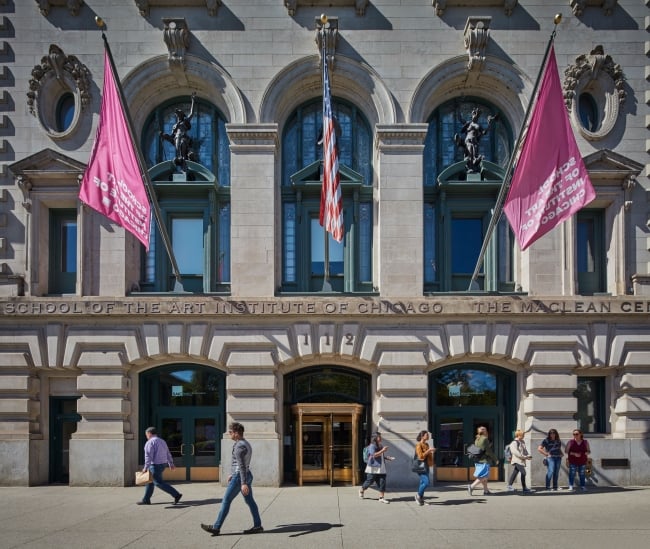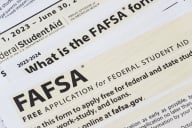You have /5 articles left.
Sign up for a free account or log in.

The School of the Art Institute of Chicago is utilizing machine learning in its admission process, in what is becoming a growing trend among higher education institutions.
Provided/School of the Art Institute of Chicago
In 2019, Kyle O’Connell had a vision of leveraging technology to boost in-person relationships with students at the School of the Art Institute of Chicago. He set out to create a machine learning-enabled system that could help with the admissions process, ultimately meant to direct employees’ energy and resources toward students in an earlier and more effective way.
“We deal with the technology, but ultimately we want to bring it back to getting more in-person time with who we can make the most impact on,” said O’Connell, director of enrollment analytics and forecasting at the Chicago institution, known as SAIC. “And there’s more information we have about students than you’re able to assess as an individual person.”
He admitted that the machine-learning attempt “didn’t knock it out of the park on the first try,” undermined by data that was not very robust. He worked to adjust the data-gathering process over the next couple years, and his timeline coincided with an opportunity to work with the Chicago technology consulting firm SPR to use machine-learning models during the application process.
At the start of 2023, SPR asked organizations to send in pitches on how to better the local community, with the winner getting $50,000 in honor of the company’s 50th anniversary. The criteria were broad—SPR received pitches on topics as diverse as drones and deforestation—but the firm ultimately chose SAIC because it “fit best with our mission” of boosting the local community, according to Steven Devoe, SPR’s data specialty director.
How It Works
Stacks of data from applicants with offers to attend SAIC are entered into the model, which parses more than 100 factors including the number of SAIC events the applicants attended, the types of programs they are interested in, and where they went to high school. It then spits back two outcomes: the likelihood a student would accept the admissions offer—say, 50 percent chance they would say “yes” to accepting an admissions offer—and then a further “yes” or “no” if a student would actually end up attending the university. Oftentimes, institutions see “summer melt” from students who accept an enrollment offer but do not end up attending.
Both O’Connell and Devoe were quick to point out the technology is not being used to dictate which students should and should not be accepted into the institution. Instead, the data illuminate the likelihood of the already-accepted students choosing to attend the university.
“There are certainly things you could do with AI that are terrible, but the things a school would do with data is want to know more about directing resources and energy toward people we can help the most,” O’Connell said. “It’s, ‘How can we find them better and earlier?’”
SPR and SAIC began working on the model in the first half of 2023 and began to utilize it in the latter half of the year. The results of using the model are largely unknown, as SAIC is still in its admissions cycle.
While O’Connell said the institution needs to spend the next several months gathering the data before ultimately deciding on more uses, Devoe believes this could ultimately lend itself to budget and time savings.
If, for example, the art school determines that students from a specific country do not have a high likelihood of accepting an offer from SAIC, its officials may spend less marketing in that country. It also helps with planning for class size and sections, with SAIC officials having a more accurate outlook on which students are likely to end up on campus.
“We created this focused on how to get more students access to higher ed, help the institute plan better and maybe spend dollars more effectively in terms of where it’s investing,” Devoe said.
He added other higher education institutions have begun reaching out to ask for similar tools or models that could be used for other purposes, such as predicting the likelihood of students dropping out in their first academic term.
AI in Admissions
This is the first time SAIC is using AI and machine learning in admissions, but many institutions across the nation have turned toward the increasingly pervasive technology.
According to a September survey from higher education-focused magazine Intelligent, half of universities were using AI in their admissions process. This year, that number is expected to jump to more than 80 percent. Institutions reported most often using AI to review transcripts and recommendation letters. Many of them stated that they used it to review personal essays as well, with some going as far as to conduct preliminary interviews with applicants using AI.
“Application readers have been mechanically doing at least the first screen of applications for decades now, based on some uniform criteria given to them by the institution,” Diane Gayeski, a professor of strategic communications at Ithaca College and a higher ed adviser for Intelligent, said in a previous interview with Inside Higher Ed.
“Some of that can easily be done by a machine,” she said. “These are all algorithms. Whether a person uses them or a machine does, it doesn’t make much difference.”
However, SAIC does seem to be the first among art- and design-focused institutions to utilize the technology in admissions. While art students typically have to submit a portfolio in the application process, Devoe stressed the machine-learning technology is not judging the portfolio in any way.
“The art portfolio, it didn't find that interesting,” he said, except for clocking which type of program a student would be interested in, such as painting or sculpture.
Many schools of art and design, while harboring some concerns, are leaning into the technology after the launch of ChatGPT late in 2022. “Even the most angry illustration faculty have said, ‘I hate it, I wish we could go traditional, but if you’re a student today you would be an idiot if you didn’t learn this before you go into the world,’” said Rick Dakan, chair of the AI Task Force at the Ringling College of Art and Design in Sarasota, Fla. “It will be part of your career.”
SAIC, upon receiving the machine-learning model for free, can utilize it as long as it sees fit. It may upgrade eventually, but for now, O’Connell is content with taking things slowly—in contrast to the normal rhythm of the quick-moving tech world.
“It’s, ‘Let’s not try to do too much; let’s start with a single thing we’re trying to look at,’” he said. “Which is, can we use the tool along with other reporting and assessments? How does this fit into our workflow? And then, what are its possibilities from there.”









